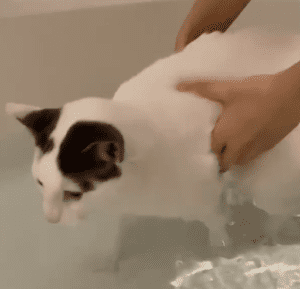The Challenge of Bathing Cats
Among the most difficult chores in pet care is typically bathing a pet cat. Unlike many dogs, cats usually dislike water; the sound of flowing water may send them sprinting for protection. Sometimes, however, depending on filth, fleas, or a medical problem, giving your cat companion a good wash becomes essential. By following the correct technique, you can easily wash a cat in a bathtub and dry it, therefore reducing stress for your pet as well as for yourself. Bathing a cat calls for preparation most of all. Having everything ready before you start the procedure will help things go as well as they could when something a cat does not appreciate.

Preparing for the Bath
Keep calm and careful before putting your cat in the bathtub. Cats can sense your tension or stress and are really clever. Try to keep the surroundings as calm as you can and gently talk to your cat. To prevent any inadvertent scratches during the wash, you could also choose to cut your cat’s nails prior.With one hand beneath the chest and the other hand firmly holding your cat, gently raise it up and gently drop it into the tub. The cat may be startled if you move quickly; hence, it’s important to prevent any such motions and complicate the matter. Having another person aid to keep your cat calm and steady may help if it looks very nervous.

The Bathing Technique
Should your cat have an oily coat or is really unclean, you might have to wash it twice. But be careful not to overdo it; too much bathing may rob the cat’s skin of its natural oils, causing dryness and discomfort. The cat should be completely shampooed before rinsing off all the suds. From the neck and working your way down, gently pour lukewarm water over the cat’s body using the cup or shower head. Make sure every bit of the shampoo is gone, as any left over might aggravate the skin. This stage of the procedure might be challenging, as some cats find the feeling of water sprayed over them unpleasant. Once again, keep your motions quiet and soft and say lots of comforting words.

Rinsing and Drying
Rinse the stomach and behind the legs very carefully, as these places could trap shampoo. Steer clear of washing the cat’s face with water; this will come later using a milder approach. Your cat has to be dried off after it is clean. Rising gently from the bathtub, support your cat’s body like you would while lowering it in. As soon as your cat comes out of the water, cover it in a big towel. While most cats won’t, Huskies may shake off the water like a dog; hence, the towel will do most of the job in absorbing the moisture. Pat the cat gently, being careful not to hurt the skin or tangle the hair by harsh rubbing. Should the first towel become very damp, you may have to use a second one. Long-haired cats may have their fur softly squeezed to eliminate extra water before drying.

Managing Long or Thick Fur
Should your cat have long or thick fur, the drying process may be assisted using a hairdryer set on the lowest heat and noise level. Still, the loudness of a hairdryer scares many cats; hence, this should be done carefully. Cats’ skin is delicate, hence, always make sure the heat level is moderate, strong heat might burn them. Stick with towel drying if your cat seems too nervous around the hairdryer. Though it could take longer, it’s best to keep the cat relaxed and cosy during the procedure. Your cat may feel a little confused or anxious after the wash; hence, it is crucial to make them feel protected and comfortable. Treats or two will reward your cat and help to establish a good link with the bathing experience.

Post-Bath Comfort
After the bath, give them a nice, cosy place to relax, perhaps a favourite blanket or bed, where they may groom themselves. After the bath, keep a close check on your cat to be sure they are warm and dry. Cats groom themselves naturally, hence, they will probably keep cleaning after the wash, however, they should be generally dry and comfortable once you have done. Though it may not be the simplest chore, bathing a pet cat in a bathtub and drying it off may be accomplished with the correct preparation and a soft approach. Although most cats dislike bathing, they are tough animals, and many will put up with the procedure if they are treated gently and patiently. You may make the experience as stress-free as possible for your cat buddy by guaranteeing peaceful surroundings, choosing the correct goods, and offering consolation later on.



















